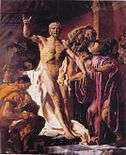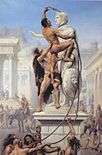Joseph-Noël Sylvestre
Joseph-Noël Sylvestre (1847–1926) was a French artist, notable for his studies of classic scenes from antiquity.[1] He was born in Béziers in South-West France on 24 June 1847, training as an artist first in Toulouse under Thomas Couture, then at the École des Beaux-Arts in Paris under Alexandre Cabanel.[1] He was an exponent of the romantic Academic art style, also known as art pompier (fireman's art), examples of which are the Death of Seneca (1875), The Gaul Ducar decapitates the Roman general Flaminius at the Battle of Trasimene (1882), The Sack of Rome by the barbarians in 410 (1890) and François Rude working on the Arc de Triomphe (1893).
Gallery
 The Death of Seneca (1875)
The Death of Seneca (1875).jpg) The Gaul Ducar decapitates the Roman general Gaius Flaminius at the Battle of Lake Trasimene (1882)
The Gaul Ducar decapitates the Roman general Gaius Flaminius at the Battle of Lake Trasimene (1882) The Sack of Rome by the barbarians in 410 (1890).
The Sack of Rome by the barbarians in 410 (1890). François Rude working on the Arc de Triomphe (1893).
François Rude working on the Arc de Triomphe (1893).
gollark: Maybe we could take out the non middle ones and I could recycle them in street signs.
gollark: Why should use of monitors be in the constitution?
gollark: Because you have no relevant skills.
gollark: Also just don't Anyway.
gollark: Tronzoid: you literally *cannot* claim a 1km*1km area.
References
- Joseph-Noël Sylvestre. Peintre pompier biterrois (1847–1926) (Exhibition catalogue, Musée des Beaux-Arts, Béziers, October 2005)
Sources
- This article began as a translation of its French equivalent.
| Wikimedia Commons has media related to: |
This article is issued from Wikipedia. The text is licensed under Creative Commons - Attribution - Sharealike. Additional terms may apply for the media files.